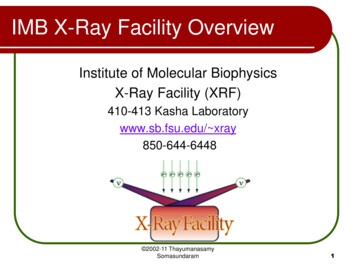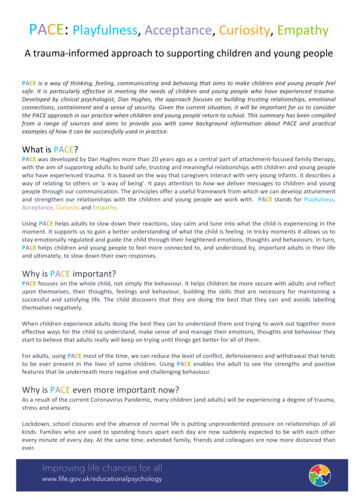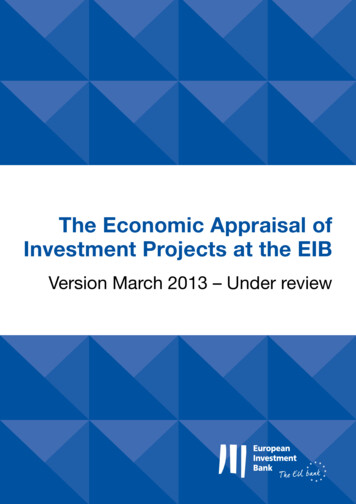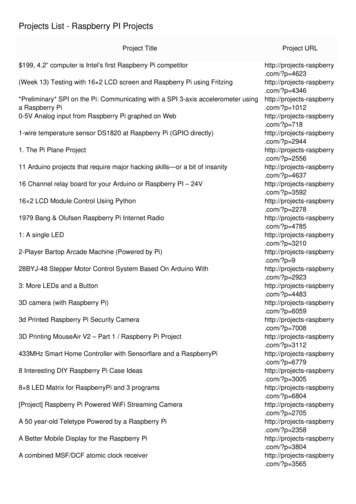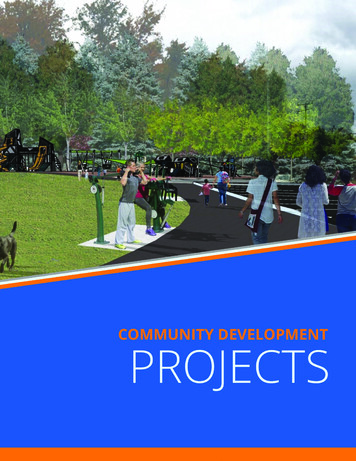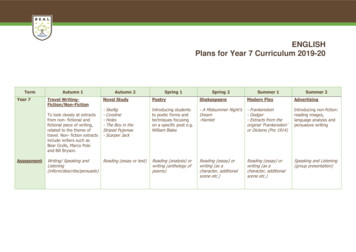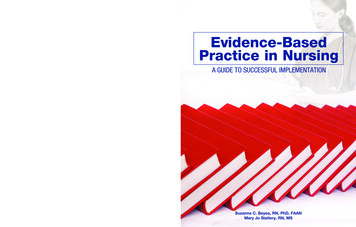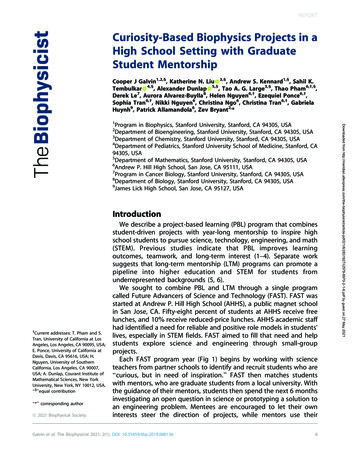
Transcription
REPORTCuriosity-Based Biophysics Projects in aHigh School Setting with GraduateStudent MentorshipCooper J Galvin1,2,§, Katherine N. Liu 3,§, Andrew S. Kennard1,§, Sahil K.Tembulkar 4,§, Alexander Dunlap 5,§, Tao A. G. Large3,§, Thao Pham6,†,§,Derek Le7, Aurora Alvarez-Buylla8, Helen Nguyen6,†, Ezequiel Ponce6,†,Sophia Tran6,†, Nikki Nguyen6, Christina Ngo6, Christina Tran6,†, GabrielaHuynh9, Patrick Allamandola6, Zev Bryant2,*Program in Biophysics, Stanford University, Stanford, CA 94305, USADepartment of Bioengineering, Stanford University, Stanford, CA 94305, USA3Department of Chemistry, Stanford University, Stanford, CA 94305, USA4Department of Pediatrics, Stanford University School of Medicine, Stanford, CA94305, USA5Department of Mathematics, Stanford University, Stanford, CA 94305, USA6Andrew P. Hill High School, San Jose, CA 95111, USA7Program in Cancer Biology, Stanford University, Stanford, CA 94305, USA8Department of Biology, Stanford University, Stanford, CA 94305, USA9James Lick High School, San Jose, CA 95127, USA2Introduction†Current addresses: T. Pham and S.Tran, University of California at LosAngeles, Los Angeles, CA 90095, USA;E. Ponce, University of California atDavis, Davis, CA 95616, USA; H.Nguyen, University of SouthernCalifornia, Los Angeles, CA 90007,USA; A. Dunlap, Courant Institute ofMathematical Sciences, New YorkUniversity, New York, NY 10012, USA.‘‘§’’equal contribution‘‘*’’ corresponding authorÓ 2021 Biophysical Society.We describe a project-based learning (PBL) program that combinesstudent-driven projects with year-long mentorship to inspire highschool students to pursue science, technology, engineering, and math(STEM). Previous studies indicate that PBL improves learningoutcomes, teamwork, and long-term interest (1–4). Separate worksuggests that long-term mentorship (LTM) programs can promote apipeline into higher education and STEM for students fromunderrepresented backgrounds (5, 6).We sought to combine PBL and LTM through a single programcalled Future Advancers of Science and Technology (FAST). FAST wasstarted at Andrew P. Hill High School (AHHS), a public magnet schoolin San Jose, CA. Fifty-eight percent of students at AHHS receive freelunches, and 10% receive reduced-price lunches. AHHS academic staffhad identified a need for reliable and positive role models in students’lives, especially in STEM fields. FAST aimed to fill that need and helpstudents explore science and engineering through small-groupprojects.Each FAST program year (Fig 1) begins by working with scienceteachers from partner schools to identify and recruit students who are‘‘curious, but in need of inspiration.’’ FAST then matches studentswith mentors, who are graduate students from a local university. Withthe guidance of their mentors, students then spend the next 6 monthsinvestigating an open question in science or prototyping a solution toan engineering problem. Mentees are encouraged to let their owninterests steer the direction of projects, while mentors use theirGalvin et al. The Biophysicist 2021; 2(1). DOI: 10.35459/tbp.2019.0001366Downloaded from ticle-pdf/2/1/6/2831927/i2578-6970-2-1-6.pdf by guest on 27 May 20211
Mentored science projects in high schoolscientific experience and ability to gather information to help develop their mentees’ ideas.Projects are conducted in 3 phases of approximately 2 months each: (1) brainstorming andproblem definition, (2) performing experiments, and (3) analyzing results and presenting work atlocal science fairs and a culminating symposium at Stanford University. Over the past 5 years,participation in the FAST program has grown significantly (Table 1), as the program has expandedfrom AHHS to operate at 3 Bay Area high schools. At AHHS, self-reported participantdemographics (Table 2) are generally reflective of the AHHS student body (7).Here, we highlight 3 examples of student–mentor teams that worked on biophysics projects, asignificant component of the FAST program. These teams illustrate the dynamics of the student–mentor relationship that FAST was designed to foster. Mentor expertise helps students adapt theirprojects over the year, but students’ personal interests control the project direction. Mentors canalso provide scientifically relevant social and cultural capital (‘‘science capital’’ [8]) that allowsTable 1. Annual FAST program ents36aaStudents who completed a project, attended over 75% of sessions, or both.bStudents who presented at the culminating symposium, completed a written project report and/or attended over 50% of sessions.Galvin et al. The Biophysicist 2021; 2(1). DOI: 10.35459/tbp.2019.0001367Downloaded from ticle-pdf/2/1/6/2831927/i2578-6970-2-1-6.pdf by guest on 27 May 2021Fig 1. FAST curriculum workflow.
Mentored science projects in high schoolTable 2. Overall FAST program statistics 2018–2020.Underrepresentedminoritiesin sciencesaWould be firstgeneration toattend college90 (n ¼ 66)53 (n ¼ 66)2018–2019b (%)77 (n ¼ 79)43 (n ¼ 82)2019–2020c (%)aAs defined by US congress bill HR4803, 2016 (13), and the National Science Foundation.bEnd-of-year survey response rate, 84% (2018–2019).cEnd-of-year survey response rate, 72%–75% (2019–2020).Seniors planning topursue STEM majors(100% are matriculating)100 (n ¼ 12)92 (n ¼ 12)Simulating the biophysical effects of climate change on lake shrimpswimmingInitially, AHHS junior and FAST participant TP said she was not ‘‘the science or engineeringtype,’’ but persisted with the program because she formed strong connections with a few of thementors. TP was interested in how climate change would affect marine life in local salt lakes,especially by altering physical and chemical properties of the lake water. After 6 wk ofbrainstorming activities with her mentors, TP proposed a project where she would vary salinity,viscosity, and pH of the water and monitor their effects on the reproduction rate of brine shrimp.The project experienced a setback as TP found she was not able to raise enough brine shrimpto gather meaningful data on reproduction rates. Thus, TP decided to switch from observingreproduction to observing swimming behavior. Her mentor suggested quantitative measurements she could make to aid her analysis. As TP varied salinity and viscosity of the water, shetracked individual shrimp swimming speeds with microscopy videos recorded on her cell phoneand free image analysis software (9). TP found that doubling and tripling salt concentrations hadno substantial effect on swimming speeds. On the other hand, adding a polymer that increasedthe viscosity by 5%–10% led to a surprising 50%–75% decrease in swimming speed.In this project, TP and her mentors transformed an unfortunate scientific setback into aninsightful science project. TP led the changes and pivoted her project on the basis of herobservations, supported by her mentor’s knowledge of biophysics, which complemented herparallel classroom learning in chemistry. TP found a community in the FAST program, and shebecame a FAST student leader the following year. As a leader, in addition to carrying out a secondproject, she helped to recruit additional students and shape the program curriculum. TP reportedthat her FAST projects inspired her to study Civil and Environmental Engineering at UCLA.Chemical composition of makeup primers affects growth of skin bacteriaAHHS sophomores CN, NN, and CT had never taken a chemistry or physics class, and they eachhad varying levels of engagement with their science classes, which ranged from ‘‘slightlyinterested’’ to ‘‘not motivated at all.’’ Over 10 weeks of iterating through ideas and readingscientific literature with their mentor, a Stanford Biology PhD student, the team refined a researchquestion that affected their everyday lives: how do various types of makeup primers lead todifferent rates of acne or bacterial growth on the surface of skin?Galvin et al. The Biophysicist 2021; 2(1). DOI: 10.35459/tbp.2019.0001368Downloaded from ticle-pdf/2/1/6/2831927/i2578-6970-2-1-6.pdf by guest on 27 May 2021students to pursue detailed and rigorous projects. Interviews with student participants suggestthat this process of student-driven project development leads to personal growth and encouragesthe pursuit of higher education in STEM fields, especially in biophysics and related disciplines.With LTM and a modest budget of 100/yr, each FAST student could create a novel, rigorousscience or engineering project in a relatively low-resource setting.
Mentored science projects in high schoolCRISPR editing and the cell cycleIn their second year participating in FAST, AHHS seniors HN, ST, and EP wanted to improveCRISPR gene editing efficiency. They identified that biophysical changes in DNA organizationduring the cell cycle may affect DNA accessibility and hypothesized that arresting cells in differentstages of the cell cycle would alter CRISPR editing efficiency. However, they did not know howthey might be able to test this in a high school on a budget.Their mentor identified a Cas9 transgenic yeast strain donated from the San Jose Tech Museumthat could be easily screened for Cas9 activity based on the color of the colony. The studentstreated yeast with cell cycle–inhibiting drugs while inducing Cas9 expression, finding thatblocking DNA replication with hydroxyurea or cell division with nocodazole increased CRISPRediting over controls by 98% or 36%, respectively.The students won a Grand Prize at the regional science fair and a trip to the InternationalScience and Engineering Fair (ISEF). The experience of attending ISEF was a ‘‘culture shock’’ for EP,where he met students from all over the world, many of whom had access to considerableresources. Despite the excitement of ISEF, HN recounts that ‘‘The biggest prize for us was gettingour results and finding out they were meaningful.’’ All 3 students were awarded collegescholarships and expressed that FAST and ISEF inspired them to pursue a STEM-related field.This project demonstrates how mentors with access to science capital (8), such as networkswith other scientific institutions, can enable students to fully pursue their ambitions.Strengths of the programThese 3 specific examples of FAST biophysics projects demonstrate the effectiveness of LTM infostering curiosity-driven, project-based informal learning. A similar pattern emerges from data ata program-wide scale, with students consistently self-reporting they are more likely to apply tocollege after participating in FAST, despite the fact that many would be the first in their family tomatriculate (Table 2).The examples also highlight key features of the FAST program that may contribute to itssuccess, such as student ownership of project directions. Students have reported that afterdeveloping a project through FAST, they have felt more empowered to express themselvesscientifically and they have better understood the process of pursuing further scientific training. Incontrast, prior work has described a disconnect between STEM content in the classroom and itspractical application in the real world (10). FAST students have also reported feeling confident inGalvin et al. The Biophysicist 2021; 2(1). DOI: 10.35459/tbp.2019.0001369Downloaded from ticle-pdf/2/1/6/2831927/i2578-6970-2-1-6.pdf by guest on 27 May 2021The students classified 6 different makeup primer brands as water-, oil-, or silicone-based andmeasured how well 2 bacterial species commonly found on the skin grew on nutrient mediasupplemented with different makeup primers. They quantitatively confirmed that oil-basedprimers led to higher levels of bacterial growth for both strains than either water- or siliconebased primers. To understand this result, they reasoned that opportunistic bacteria may colonizeareas of the skin following an overproduction of oil, which leads to inflammation.All 3 students reported that this project helped them learn important lessons about timemanagement and resilience and increased their motivation in science classes. NN wrote, ‘‘FASThas allowed me to gain more confidence in my abilities to present my ideas and it has given mean outlet for my creativity. My ability to express my thoughts in a more meaningful way hasmarkedly improved. I am eager to experiment and ask more questions about the unknown.’’ Thestudents successfully presented this project at local science fairs, and then were invited tocompete at the California Science & Engineering Fair. The next year, NN, CN, and CT all returned toFAST to pursue new research questions. This case study demonstrates how student interest in areal-world problem (side effects of different cosmetics) was built into a rigorous scientific projectwith mentor guidance.
Mentored science projects in high schoolFuture directionsWork is ongoing to broaden participation continually in Stanford FAST via inclusive recruitment.Efforts are also ongoing to assess program outcomes quantitatively through evidence-basedsurveys administered over the course of the academic year. Analysis of these survey data willinform efforts to improve the quality and reproducibility of the program. Former FAST studentorganization leaders have started a FAST 501(c)(3)–designated charitable organization (fastprogram.org) for supporting the development and dissemination of FAST to broader audiences andnew chapters. For educators interested in starting chapters or similar programs, key ingredientswill include commitments from enthusiastic science teachers together with demonstrated needsarising from students who have potential science interests but are lacking access to resources orscience capital.ACKNOWLEDGMENTSWe acknowledge the work of the FAST leadership team and many mentor volunteers over the past 5 years who havecontributed to the program’s growth and success. We also acknowledge more than 200 students who have completed theprogram and provided feedback that informs our understanding of the key elements of the program. CJG, KNL, and AD weresupported by the National Science Foundation Graduate Research Fellowship program.AUTHOR CONTRIBUTIONSOriginal manuscript development: CJG, KNL, ASK, SKT, AD, TAGL. Case study supporting materials: TP, DL, AAB, HN, EP, ST, NN,CN, CT. Case study interviews: KNL, ASK, AD, CJG. Program supervision: CJG, KNL, ASK, AD, GH, PA. Manuscript editing andorganization: CJG, KNL, ASK, SKT, AD, TAGL, PA, ZB.REFERENCES1. Dyke, P., K. Jamrozik, and A. J. Plant. 2001. A randomized trial of a problem-based learning approach for teaching epidemiology. Acad Med 76(4):373–379.2. Harris, C. J., W. R. Penuel, C. M. D’Angelo, A. H. DeBarger, L. P. Gallagher, C. A. Kennedy, B. H. Cheng, and J. S. Krajcik. 2015. Impact of project-based curriculum materials onstudent learning in science: results of a randomized controlled trial. J Res Sci Teach 52(10):1362–1385.3. Finkelstein, N., T. Hanson, C.-W. Huang, B. Hirschman, and M. Huang. 2010. Effects of Problem Based Economics on High School Economics Instruction. Final Report. NCEE2010-4002. National Center for Education Evaluation and Regional Assistance, Washington, DC.4. Barak, M., and Y. J. Dori. 2005. Enhancing undergraduate students’ chemistry understanding through project-based learning in an IT environment. Sci Educ 89(1):117–139.5. Hudson, J. K., and B. G. Hudson. 2019. Aspirnaut: a rural high school pipeline to increase diversity in STEM. Nat Rev Nephrol 15(10):591–592.6. Robinson, M. A., M. B. Douglas-Vail, J. N. Bryce, and T. J. van Zyl. 2017. Medical school outreach and mentorship for rural secondary school students: a pilot of theSouthwestern Ontario Medical Mentorship Program. Can J Rural Med 22(2):62–67.7. Andrew P. Hill High School. 2019. School profile 2019–2020. Accessed August 2019. rofile%2019-20.pdf.Galvin et al. The Biophysicist 2021; 2(1). DOI: 10.35459/tbp.2019.00013610Downloaded from ticle-pdf/2/1/6/2831927/i2578-6970-2-1-6.pdf by guest on 27 May 2021the science-related skills they developed. This development process is typical of effective PBL,wherein students derive a better understanding of scientific content by engaging directly inproblem-solving and critical thinking (11, 12).The case studies presented here demonstrate that successful mentorship involves connectingstudents to their mentors’ science capital (8). This can manifest as guidance—stemming from thementors’ technical experience—that allows students to adapt their project over the course of theyear. Additionally, mentors have knowledge of specific resources that allow students to surpasscommon expectations of high school science project depth and rigor. It is possible that thesepractices are particularly effective for interdisciplinary subjects like biophysics; in our experience,students are curious about biophysical questions but have not covered enough material in highschool to be able to design the experiments independently to test their questions without someguidance from their mentor.FAST mentors are motivated to join the program to support the development of the nextgeneration of scientists and inventors. By joining a graduate student volunteer community,mentors are able to build confidence and develop their mentoring skills. Mentors have alsoreported growth in their perspectives of the capabilities of underprivileged/underresourcedstudents.
Mentored science projects in high school8. Archer, L., E. Dawson, J. DeWitt, A. Seakins, and B. Wong. 2015. ‘‘Science capital’’: A conceptual, methodological, and empirical argument for extending Bourdieusiannotions of capital beyond the arts. J Res Sci Teach 52(7):922–948.9. Rueden, C. T., J. Schindelin, M. C. Hiner, B. E. DeZonia, A. E. Walter, E. T. Arena, and K. W. Eliceiri. 2017. ImageJ2: ImageJ for the next generation of scientific image data.BMC Bioinformatics 18(1):529.10. Sahin, M. 2009. Correlations of students’ grades, expectations, epistemological beliefs and demographics in a problem-based introductory physics course. Int J Environ Sci4(2):169–184.11. Bruce-Davis, M. N., E. J. Gubbins, C. M. Gilson, M. Villaneuva, J. L. Foreman, and L. D. Rubenstein. 2014. STEM high school administrators’, teachers’, and students’perceptions of curricular and instructional strategies and practices. J Adv Academics 25(3):272–306.12. Marx, R. W., P. C. Blumenfeld, J. S. Krajcik, and E. Soloway. 1997. Enacting project-based science. Elem Sch J 97(4):341–358.13. Women and Minorities in STEM Booster Act of 2016, 4803, House of Representatives, 114th Congress (2016). -bill/4803Downloaded from ticle-pdf/2/1/6/2831927/i2578-6970-2-1-6.pdf by guest on 27 May 2021Galvin et al. The Biophysicist 2021; 2(1). DOI: 10.35459/tbp.2019.00013611
1Program in Biophysics, Stanford University, Stanford, CA 94305, USA 2Department of Bioengineering, Stanford University, Stanford, . We describe a project-based learning (PBL) program that combines student-driven projects with year-long mentorship to inspire high school students to pursue science, technology, engineering, and math .
